As we covered in previous articles, the video game localization process requires time and resources, and it’s best performed by experts working side-by-side with game developers.
In this post, we’ll explain:
We’ll also be answering some common questions regarding costs and timescales.
Let ‘s begin.
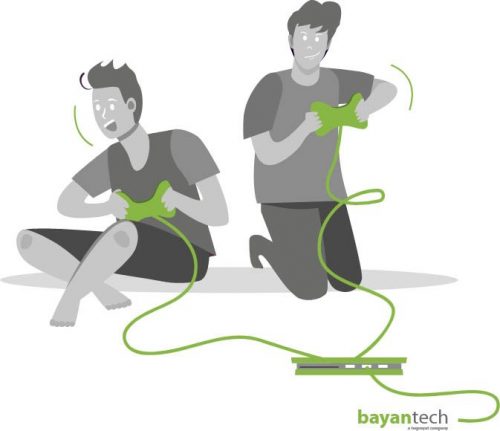
The Basics of the Video Game Localization Process
Game localization doesn’t just involve the translation of a game script. As an essential process for a game’s global success, the video game localization process involves the reimagining of the game’s core concepts so they can be understood and assimilated by international audiences. More specifically, by players in a particular target locale.
In this section, we’ll take a look at the general steps of the video game localization process.
Every video game localization process is different. But it’s useful to create a model of the video game localization process that allows us to focus on the most likely needs a team will have in each step.
Some of the factors that will affect how a project will unfold are:
- The differences between the source and target cultures
- Differences between the source and target writing systems
- The way the game is coded (language, conventions, and platforms)
- Priorities and stages of development
- The translation management tools the team uses
- The approach implemented by project management

But generally, one can understand the video game localization process as consisting of seven steps:
The Video Game Localization Process, Step by Step
In this section, we’ll examine each step of the video game localization process individually.
1. Familiarization
Video games are often dense with lore, subtle references to previous games from the company or the saga, etcetera. To understand these aspects of the game, as well as the most rudimentary and frontal elements, the video game localization services provider’s team needs to play the game.
Aside from gameplay, the team may have a meeting with the original writers and developers, and/or receive relevant material from the original game’s creators. Namely, that piece of relevant material is what we in the video game industry call a localization kit.
A localization kit will include at least the following elements:
- An overview of the game’s world
- A description of the target player
- A brief style guide
- A short bio of relevant characters
- An explanation of each tag and piece of content code
A localization team that understands a game will be better equipped to make decisions that may affect how the player perceives a certain character or situation. For instance, if there’s a character who’s a famous jokester within the game, and they say an untranslatable joke, a team that’s familiar with the lore will go out of their way to keep the joke effective.
A Compact Guide to the Video Game Localization Process
Whether to streamline project management or to communicate with stakeholders, our compact guide to the video game localization process
is the tool you need.
2- Source material collection and code assessment
Once everyone understands the game and what it’s about, the next step usually consists of collecting all the elements of the game that will need to be localized.
This step may also involve auditing the original game’s code and developing a strategy to streamline the localization engineers’ workflow and prevent code-related errors.
At this stage, the localization team’s developers may perform pseudolocalization. Pseudolocalization consists of testing whether the game’s existing interface is prepared to host text in another language. This evaluation is carried out by “feeding” a linguistically neutral series of characters into the interface, instead of its usual content, and checking for any breaks or inconsistencies in the UI.

3- Translation & development of localized assets
The next step consists of translating the game’s script and developing the necessary assets (costumes or objects, for instance).
Translating the game’s script and developing locale-specific elements isn’t as discreet as the familiarization or assembly stages. It’s a process in itself, and it can take several months and plenty of back-and-forths to complete. It’s worth bringing up that the whole game localization process is bound to take at least a couple of months.
At this stage, it’s essential for the localization team to have:
- State-of-the-art tools that allow them to focus on the most complex tasks and automate repetitive ones.
- Goal-oriented project managers that encourage the team to implement best practices for game localization.
- A solid line of communication with the original writers and developers.
- A goal-oriented approach.
4- Interface localization
Interface localization is vital to make sure an interface can be easily understood and navigated by users in your target locale.
As one of the central aspects of software localization (and of the video game localization process), interface localization is all about changing any elements in the interface that may need to be changed for maximum usability or to better fit the new on-screen text.
The interface localization stage often “bleeds” into the next step, assembly.
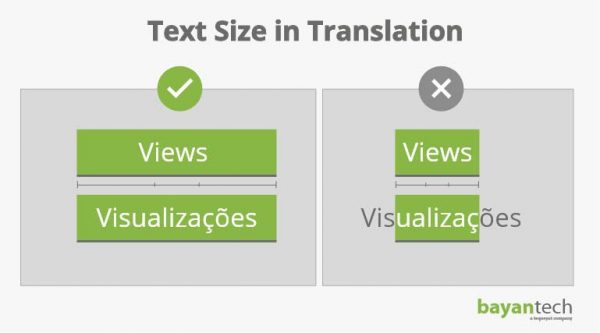
5- Assembly
Like its name indicates, the assembly stage consists of taking all the parts of the game that have been adapted (the new, locale-specific elements, the script, any voice-over, etcetera) and assembling them.
Assembly is carried out by localization engineers, whether working with the localization services provider or in-house
Who will carry out the assembly stage will often depend on whether the video game localization process is taking place during development or after development. We’ll take a closer look at this distinction in a moment.
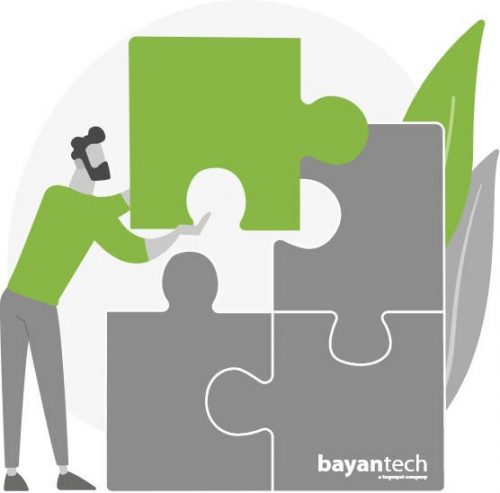
6- Linguistic & functional testing
Some may say that a localization is as good as its testing stage. Quality control is a constant exercise that began even before the localization process, through the implementation of best practices and the design of effective workflows. But quality assurance and testing are one of the last stages of the video game localization process.
There are several types of testing. Linguistic testing is focused on translation quality. Functional testing focuses on more structural aspects of the in-game experience.
Usually, in the content of the video game localization process, testing involves playing the game and pointing out functional and linguistic shortcomings.
During video game development, on the other hand, testing is progressive and hyper-focused. Every new feature is tested independently, and testers perform very specific tasks, such as “collision-testing” (getting a character on every solid surface to test whether they’re solid enough).

7- Final delivery
Testing is often a non-linear process that invites the team to reevaluate and reiterate steps of the video game localization process that were thought of as concluded.
In the final delivery stage, the client is provided with a fully functional version of the game. In most cases, this “final” version isn’t really final. Instead, the developer will take on their own rounds of testing, through focus groups or multilingual members of their in-house team.
If provided with actionable feedback, the localization team will fix the product accordingly.
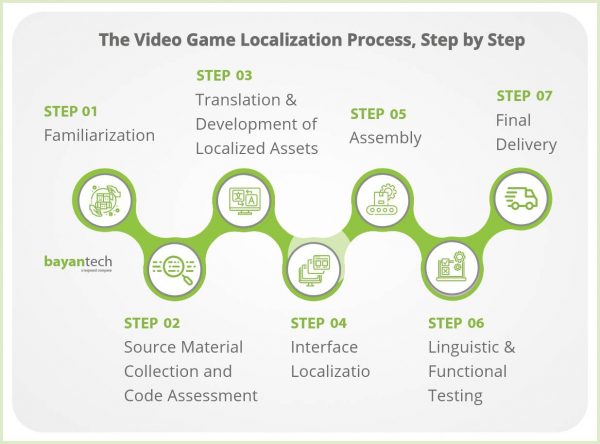
Localizing During Developments vs. Localizaing After Release
AAA game developing companies that release games for global markets on specific, widely anticipated dates may be able to localize their games during development. In these cases, game developers, scriptwriters, and other creatives work side-by-side with in-house localization teams.
Global games are often developed with internationalization in mind. That is, they’re created as blank slates for slightly different narratives and elements to be printed upon during the video game localization process.
But, in extremely fast-paced and stressful game development environments, even when the resources to carry out internationalization parallelly with development are available, a team may not be able to implement this approach.
On the other hand, when a game has been developed with a very small budget (whether by indie developers, or a large company that underestimated its outreach), the product will most likely be localized after its release.
Let’s take a look at the pros and cons of its approach.
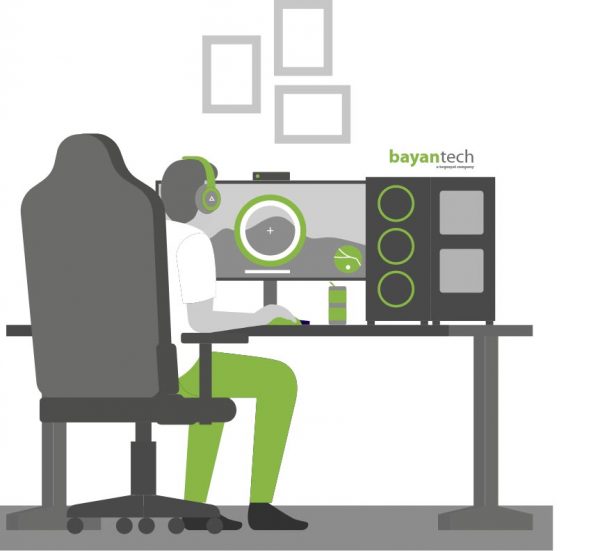
Localizing During Development
Localizing during development makes it possible for developers to implement internationalization from day one.
The greatest downside of localizing during development is that it demands considerable human and technological resources, as well as a high degree of certainty regarding target markets.
AAA studios can localize during development because their games are released at an international scale, so localization is almost guaranteed to have an ROI.
When a game is bound to have an international reception, localizing during development is the most cost-efficient approach. Approaching development and the video game localization process simultaneously prevents the presence of “unlocalizable” game elements and makes it easier to plan for a good in-game experience across locales.
But, it’s worth bringing up that, in stressful, fast-paced work environments, localizing during development may be ineffective, only serving as a way to stretch your team too thin.
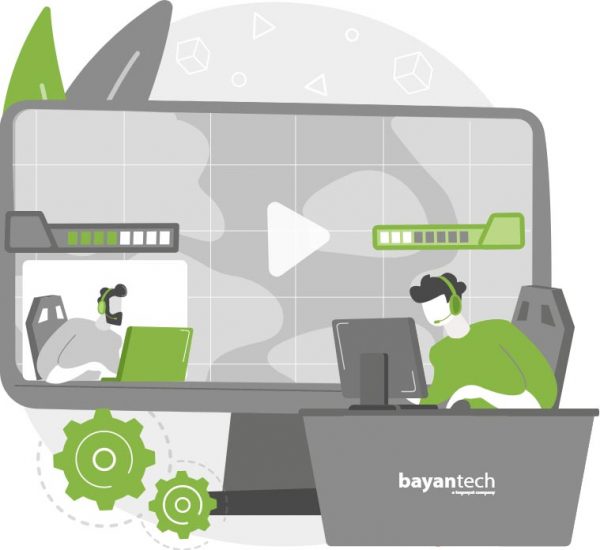
Localizing After Release
Conducting the video game localization process after release, targeting a very specific international market is often the only possible approach for small developers.
The greatest downside of getting a game translated and localized after release has to do with having to reverse-engineer solutions.
Developers that craft different versions of the game for different locales as part of the general development process usually have more resources and time to create a congruent game despite cultural incongruencies.
But localization teams working with a fully finished and released product are more likely to face insolvable problems and deal with items that are so culture-specific that they’re impossible to localize.
Common Game Localization Problems
Aside from dealing with seemingly “non-localizable” elements, there are some common challenges that a team is bound to face during the video game localization process.
Let’s take a general look at three major potentially problematic fronts:
- Code-related challenges
- A game’s backstory and audience expectations
- Regulation
Code-Related Challenges
In most cases, localizing a video game carries code-related challenges. On rare occasions, these challenges are related to how a game is coded. For instance, an indie game made by an amateur may have its script hard-coded into its logic, making it very likely for translators to accidentally break the game.
But, at a professional level, hard-coding is extremely rare. Especially in this day and age.
As of 2021, there are two rather common code-related challenges worth bringing up:
- The possibility of misplacing the control code (for instance, a placeholder that will display the player’s name dynamically) within the translated text. This challenge is more a communication challenge than a code challenge, but it’s related to code. The best way to prevent it is by creating a control code “glossary” in the localization kit.

- Localizing a messy codebase. Even if the script isn’t hard-coded, you’ll have to dive into the code. At the end of the day, localization isn’t just translation. If the original game’s code is unstable or disorganized “spaghetti code”, any slight change can be game-breaking. Whether it’s censoring a problematic element or replacing a font.
A Game’s Backstory and Audience Expectations
While a native speaker of the game’s target language should be able to properly translate sayings and metaphors, very often, a game has a story (and a backstory) that adds a new meaning to seemingly generic phrases. Or that has to be understood to properly translate certain terms.
To the difficulties of translating a story, add the difficulty of meeting audience expectations. As a demographic, gamers (and especially some saga’s fans) tend to be very detail-oriented and uphold very high standards when it comes to how a character or story is portrayed.
If, when you localize your game, you significantly change a beloved character’s tone of voice, players may end up feeling underwhelmed and even frustrated with your game.
While the need to adapt the particularities of a game is undeniable, localization teams often have to deal with the subjects treated in a game in a more general fashion.
Sign up to our newsletter to receive the latest blogs and news.
The video game localization process can be particularly efficient and dynamic when the team in charge is integrated by seasoned linguists who know the game’s general topic. Be it the Second World War or tennis.
As Miguel Á. Bernal-Merino, a Lecturer in Media Translation at Roehampton
University wrote in a 2007 academic article, there are games that require more research than creativity, and others that are the exact opposite.
Games with heavy pop culture references, history-related games, and sports games can’t be translated by a team that’s not proficient with the terminology and culture that surrounds that product, event, or discipline.
“In a way, the best translators are like chameleons when it comes to changing tongues”, Bernal-Merino writes, “because they can make their language blend in seamlessly with the right linguistic context.”
Regulation
Across the world, the gaming market is regulated by official institutions that regulate the availability of video games for certain audiences.
In countries like Japan and the United Arab Emirates, they often require changes to a game’s content, even when assigning it an 18+ rating.
Being aware of the demands of local regulation through the localization process can be the difference between a cost-effective and comprehensive localization process and an inefficient one.
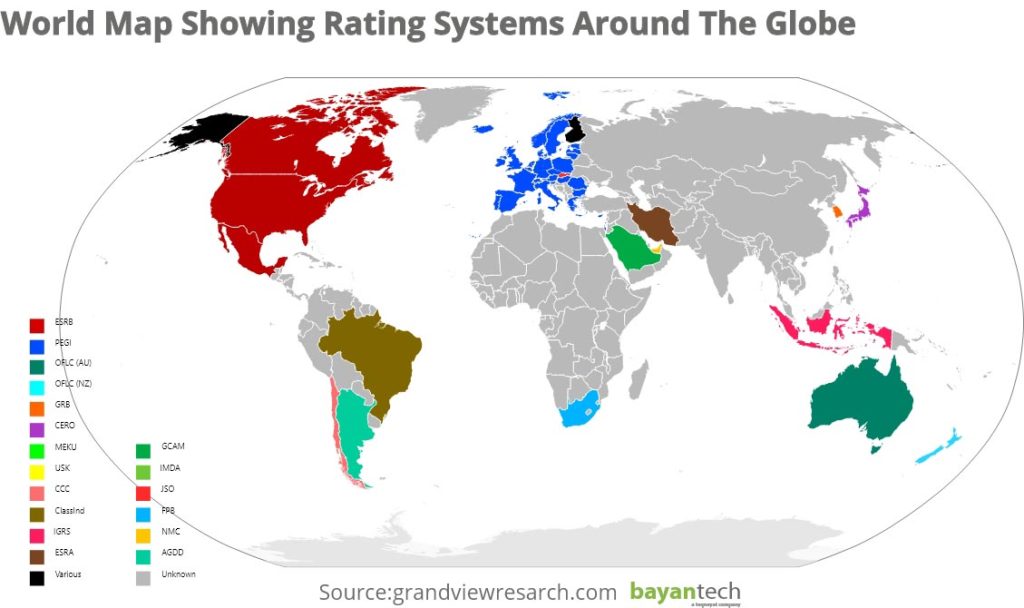
Prevent Game Localization Problems. work with the Best
Whether you’re a decision-maker playing in the major leagues, or an indie developer making their big break, a professional game localization company can be your greatest ally to unleash unprecedented growth and delight millions around the world.
At bayantech, we’re seasoned localization specialists, with almost two decades partnering up with leading brands in the MENA region and beyond. Our cross-disciplinary teams work with state-of-the-art game localization tools to help you deliver exceptional experiences to your players, regardless of where they’re from.









